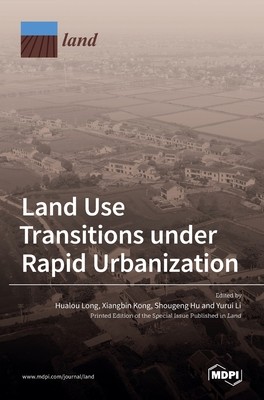
- We will send in 10–14 business days.
- Publisher: MDPI AG
- ISBN-10: 3036521135
- ISBN-13: 9783036521138
- Format: 17 x 24.4 x 4.3 cm, hardcover
- Language: English
- SAVE -10% with code: EXTRA
Land Use Transitions under Rapid Urbanization (e-book) (used book) | bookbook.eu
Reviews
Description
Land use transition is the manifestation of land use and land cover change (LUCC) and is also a major research focus of the Global Land Project (GLP), as well as land system science (LSS). Land provides essential resources to society, and its changes have large consequences for the local and global environment and human well-being. The past, current, and projected state and dynamics of land use represent the major focus of land use science, which is influenced by long-term anthropogenic changes. The concept of land use transition highlights the fact that land use change demonstrates a non-linear process and is related to other societal and biophysical disturbances through a series of transitions.
Land use transitions can be seen as the primary forces driving the transformation and development of the rural-urban territorial system and bringing about direct socioeconomic and environmental effects on regional sustainability. Land use transitions can be measured by changes in both the dominant morphology (e.g., quantity, structure, and spatial patterns) and the recessive morphology (e.g., quality, property rights, management mode, fixed input, productive ability, and function) of land use.
The aim of this book was to detect or examine the processes, patterns, and socioeconomic and environmental effects of land use transitions and the mechanisms of human-land interactions against the context of rapid urbanization and industrialization from a wide range of perspectives, as well as the provision of solutions for sustainable land use based on scientific findings.
EXTRA 10 % discount with code: EXTRA
The promotion ends in 16d.21:24:49
The discount code is valid when purchasing from 10 €. Discounts do not stack.
- Publisher: MDPI AG
- ISBN-10: 3036521135
- ISBN-13: 9783036521138
- Format: 17 x 24.4 x 4.3 cm, hardcover
- Language: English English
Land use transition is the manifestation of land use and land cover change (LUCC) and is also a major research focus of the Global Land Project (GLP), as well as land system science (LSS). Land provides essential resources to society, and its changes have large consequences for the local and global environment and human well-being. The past, current, and projected state and dynamics of land use represent the major focus of land use science, which is influenced by long-term anthropogenic changes. The concept of land use transition highlights the fact that land use change demonstrates a non-linear process and is related to other societal and biophysical disturbances through a series of transitions.
Land use transitions can be seen as the primary forces driving the transformation and development of the rural-urban territorial system and bringing about direct socioeconomic and environmental effects on regional sustainability. Land use transitions can be measured by changes in both the dominant morphology (e.g., quantity, structure, and spatial patterns) and the recessive morphology (e.g., quality, property rights, management mode, fixed input, productive ability, and function) of land use.
The aim of this book was to detect or examine the processes, patterns, and socioeconomic and environmental effects of land use transitions and the mechanisms of human-land interactions against the context of rapid urbanization and industrialization from a wide range of perspectives, as well as the provision of solutions for sustainable land use based on scientific findings.


Reviews